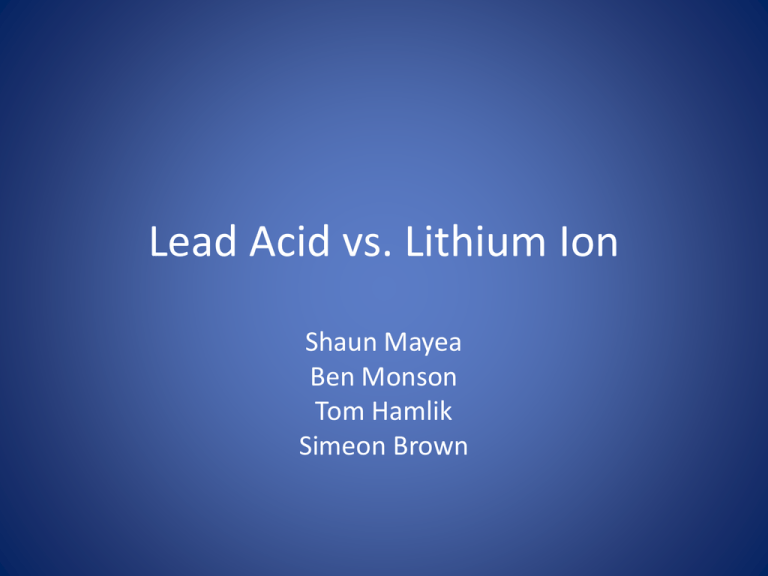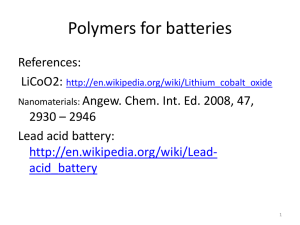Lead Acid vs lithium ion
advertisement

Lead Acid vs. Lithium Ion Shaun Mayea Ben Monson Tom Hamlik Simeon Brown Lead Acid Batteries Lead Acid Electrochemistry Lead Acid Standard vs. Deep Cycle Both car batteries and deep cycle batteries are lead-acid batteries that use exactly the same chemistry for their. Starting (sometimes called SLI, for starting, lighting, ignition) • large current for a very short time. • large number of thin plates maximize surface area. The plates are composed of a Lead "sponge " • if deep cycled, sponge will quickly be consumed and fall to the bottom of the cells. • generally fail after 30-150 cycles if deep cycled. Deep cycle • steady current over a long period of time • designed to be discharged down as much as 80% time after time, • have much thicker plates. SOLID Lead plates - not sponge. • less surface area, less "instant" power like starting batteries need. Although these an be cycled down to 20% charge. Typical battery ratings: CCA (Cold Cranking Amps) - The number of amps that the battery can produce at 32 degrees F (0 degrees C) for 30 seconds RC (Reserve Capacity) - The number of minutes that the battery can deliver 25 amps while keeping its voltage above 10.5 volts Typically, a deep cycle battery will have two or 3x the RC of a car battery, but will deliver 1/2 or 3/4 the CCAs. In addition, a deep cycle battery can withstand several hundred total discharge/recharge cycles, while a car battery is not designed to be totally discharged. Lithium Ion Pack Lithium Ion Electrochemistry Types of Lithium Ion Chemical Name Lithium Cobalt Oxide (Also lithium-ion-cobalt) Lithium Manganese Oxide (also Lithium-ionmanganese) Lithium Iron Phosphate Lithium Nickel Manganese Cobalt Oxide Lithium Nickel Cobalt Aluminium Oxide Lithium Titanate Material Abbreviation Short form Notes High capacity; for cell Li-cobalt phone laptop, camera Most safe; lower LI-manganese capacity than Licobalt but high specific power and long life. Li-phosphate Power tools, e-bikes, EV, medical, hobbyist. NMC LICoO2 LCO LIMn2O4 LMO LiFePO4 LFP LiNiMnCoO2 NMC LiNiCoAlo2 NCA NCA li4Ti5O12 LTO Li-titanate Gaining importance in electric powertrain and grid storage Charging Lead Acid Charge Cycle Lithium Ion Charge Cycle Cycling Depth of Discharge • The 2 tables compare the number of discharge/charge cycles a battery can deliver at various DoD levels before the battery is worn out. Assume end of life, when the battery capacity drops to 70 percent. Deep Cycle SLA Lithium Ion Depth of Discharge Discharge Cycles Depth of Discharge Discharge Cycles 100% DoD 175 100% DoD 500 50% DoD 450 50% DoD 1500 25% DoD 1250 25% DoD 2500 10% DoD 2000 10% DoD 4700 Cost Weight Voltage V Cost $ Weight Lbs. Voltage V Cost $ Weight Lbs. 2V $10.0015.00 .5-1 lbs Racing 12.8V $420.00 1.95 lbs 4V $13.0026.00 2-2.75 lbs Racing 16 V $1,051.00 4.44 lbs Car 12.8v $525.00 6V $8.00215.00 2-150 lbs 4 lbs and 7in x 6in x 3in dimensions 8V $28.00 2 lbs Marine 12V $630.00 4.14 lbs Marine 12.8V $936.00 4.44 lbs Marine 16V $1,262.00 6.12 lbs Marine 25.6V $1,995.00 20 lbs 12V $13.00470.00 1.5-160 lbs Car > 20 lbs Energy densities of common battery chemistries. What could this mean for our Zap car • Offers at least 4Xthe life of standard lead-acid batteries and 2X the driving range. The new • Drop-in replacement battery system that fits in the same space as the OEM lead acid batteries used in many of ZAP’s vehicles • ZAP estimates lead-acid batteries have 300-500 cycles of discharging and recharging, compared to 2,000 cycles for lithium. • Customers should see improved acceleration and handling of their vehicles with the lighter-weight, higher-voltage batteries. • Chart - ZAP Lithium Battery System vs. Lead-Acid











